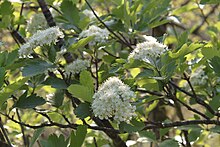
The rowans or mountain-ashes are shrubs or trees in the genus Sorbus of the rose family, Rosaceae. They are native throughout the cool temperate regions of the Northern Hemisphere, with the highest species diversity in the Himalaya, southern Tibet and parts of western China, where numerous apomictic microspecies occur. The name rowan was originally applied to the species Sorbus aucuparia and is also used for other species in the genus Sorbus.

Sorbus is a genus of over 100 species of trees and shrubs in the rose family, Rosaceae. Species of Sorbus (s.str.) are commonly known as rowan or mountain-ash. Currently, species commonly known as whitebeam, chequer tree and service tree are classified in other genera, so that genus Sorbus includes only the pinnate leaved species of former subgenus Sorbus.
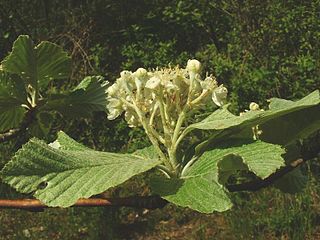
The whitebeams are members of the family Rosaceae, comprising a number of deciduous simple or lobe-leaved species formerly lumped together within Sorbus s.l. Many whitebeams are the result of extensive intergeneric hybridisation involving the genera Sorbus, Aria, Torminalis and Chamaemespilus. As an effect, they are commonly apomicts and many have very restricted ranges. The best known species is the common whitebeam, a columnar tree which grows to 25 m (82 ft) tall by 10 m (33 ft) broad, with clusters of white flowers in spring followed by speckled red berries in autumn (fall).
The Arran whitebeams are species of whitebeam endemic to the island of Arran, Ayrshire, Scotland.
Hedlundia pseudomeinichii, known as false rowan and Catacol whitebeam, is a rare species of tree endemic to the Isle of Arran in south-western Scotland. It is believed to have arisen as a hybrid of the native European rowan and the cut-leaved whitebeam which is in turn a rowan/Arran whitebeam hybrid. Until 2020, only one living specimens of the Catacol whitebeam was known, at the time making it the rarest tree not only in Scotland, but joint rarest in the world with Wood's cycad. Another was recorded as a sapling, but is believed to have been destroyed by deer. A seedling and grafted plants have also been grown in Edinburgh.
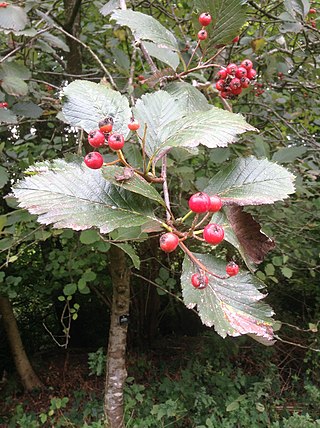
Hedlundia anglica, the English whitebeam, is a species of whitebeam tree in the family Rosaceae. It is endemic to Ireland and the United Kingdom, with an entire British population estimated at 600 individuals.

Hedlundia arranensis, sometimes referred to as the Scottish or Arran whitebeam, is a species of plant in the family Rosaceae. It is endemic to the island of Arran in Scotland.
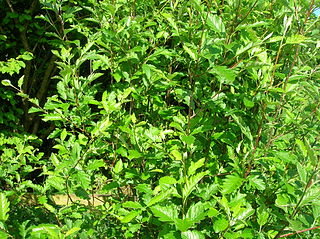
Hedlundia pseudofennica, also called Arran service-tree or Arran cut-leaved whitebeam, is a species of plant in the family Rosaceae. Endemic to the Isle of Arran in Scotland, it is threatened by habitat loss. It is thought to be a naturally occurring hybrid between H. arranensis and Sorbus aucuparia, probably with additional backcrossing with S. aucuparia. Hedlundia arranensis is itself a hybrid between Aria rupicola and S. aucuparia. Apomixis and hybridization are common in some groups of Sorbus species.
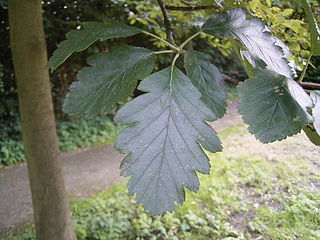
Scandosorbus intermedia or, formerly, Sorbus intermedia, the Swedish whitebeam, is a species of whitebeam found in southern Sweden, with scattered occurrences in Estonia, Latvia, easternmost Denmark (Bornholm), the far southwest of Finland, and northern Poland.

Hedlundia hybrida, the Swedish service-tree, Finnish whitebeam, or oakleaf mountain ash, is a species of whitebeam native to Norway, eastern Sweden, south-western Finland, and locally in Latvia.
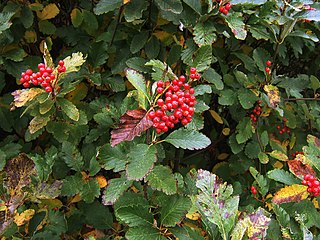
Hedlundia mougeotii, the Vosges whitebeam or Mougeot's whitebeam, is a species of whitebeam native to the mountains of central and western Europe from the Pyrenees east through the Alps to Austria, and north to the Vosges Mountains.

Hedlundia minima, commonly known as the lesser whitebeam or least whitebeam, is a deciduous shrub in the rose family Rosaceae. It belongs to the genus Hedlundia, which includes species that have arisen from a hybridisation between members of the genus Sorbus (rowans) and members of genus Aria (whitebeams). It is an apomictic microspecies that reproduces only asexually, and is endemic to Wales.
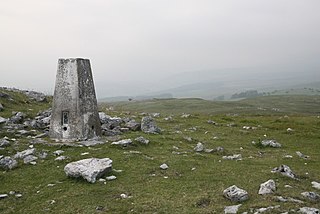
Cefn Cil Sanws is a hill in the Brecon Beacons National Park within Merthyr Tydfil County Borough in south Wales. The summit at 460m above sea level is crowned by a trig point. The steep cliffs of Darren Fawr and Darren Fach defend its western side which drops down into Cwm Taf. A major limestone quarry is worked on the southeastern side of the hill. An unexpected feature at this altitude is Merthyr Tydfil Golf Course which extends high onto the eastern and southern slopes of the hill.

Karpatiosorbus admonitor, previously classified as Sorbus admonitor and also called the Watersmeet whitebeam, is a species of whitebeam tree found in Devon, United Kingdom. It is known only from the Watersmeet Valley at Lynton, with two stray plants growing on the coast above Sillery Sands, Countisbury. It has also been nicknamed the "no parking whitebeam" in some newspapers.
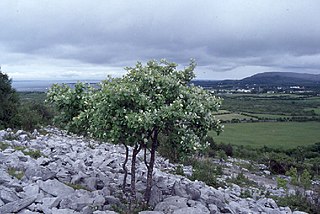
Aria hibernica, commonly known as Irish whitebeam, is a species of whitebeam endemic to Ireland. It occurs in most counties, usually as scattered individuals, or in small groups.

Aria porrigentiformis, commonly known as the grey-leafed whitebeam, is a species of whitebeam endemic to England and Wales.
Hedlundia scannelliana, commonly known as Scannell's whitebeam, is a species of shrub or tree endemic to Ross Island near Killarney in southwest Ireland. It is one of the rarest tree species in the world; only five individual plants are known.
Aria leighensis, commonly known as Leigh Woods whitebeam, is a rare species of whitebeam, a flowering plant in the|rose family Rosaceae.

Hedlundia is a genus of plants in the rose family. They are shrubs or small trees that have a hybrid origin involving crosses between Aria and Sorbus sensu stricto. There are about 48 species are distributed across central, western and southern Europe, Scandinavia, Turkey, the Caucasus, Crimea, and also central Asia. The term Hedlundia was published in 2017.
